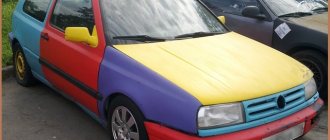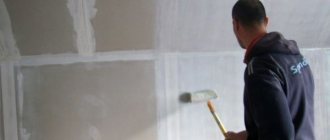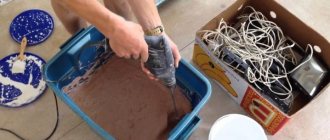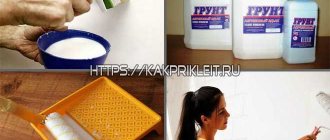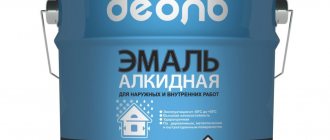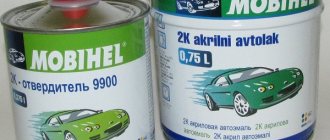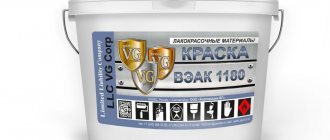Primer PLITONIT 1 concentrate 10 l
See also:. Is it possible to apply a deep penetration primer to OSB and then plaster? Is there a state standardization standard for deep penetration primer?
How to make a deep penetration primer yourself?
Primers (acrylic penetrating)
What are the methods for applying deep penetration primer? What determines the price of a deep penetration primer? How to clean furniture from deep penetration primer? Will deep penetration primer freeze in the cold, can it be used after defrosting?
The Ceresit CT 17 primer is intended for preparing the surface before installing ceramic cladding, laying leveling compounds for the floor, attaching insulating boards, painting, etc. Ceresit CT 17 is used for treating walls and floors for interior and exterior work.
Where can I use the remaining deep penetration primer, or just throw it away? Rinse tools and containers with water immediately after use. When performing external work, it is necessary to protect the treated surface from precipitation until it dries.
After freezing, it must be kept at room temperature until completely thawed, without forced heating. The shelf life in unopened manufacturer's containers is 24 months from the date of manufacture.
Use gloves when performing work. Avoid contact of primer with skin and eyes. In case of contact with eyes, rinse them immediately with plenty of water! Contact your doctor. Can be purchased for .50 points. General construction materials Dry building mixtures and waterproofing Thermal insulation and sound insulation Materials for dry construction Wood-based materials Lumber Power tools and components Roofing, siding, drainage systems Paint and varnish materials Foams, adhesives, sealants Ceramic tiles and grouts Finishing of walls and ceilings Floor coverings Doors, windows, hardware Engineering plumbing Heating and pumping equipment Plumbing Electrical equipment Cable and accessories Climate control equipment Hand tools, workwear, household goods Fasteners Garden and seasonal goods.
Hot selection of the hottest products of the season at competitive prices. Gross Weight: You may need. Rollers Brushes Household goods Demi-season overalls Related painting Stepladders Construction ladders Bags, bags, boxes, stretch Scotch tape, tape, electrical tape Painting tables, platforms.
View all. Velor roller 50 mm for handle d6mm set of 2 pcs.
What affects the mass of paintwork materials - factors
Microfiber roller Beorol mm for handle d6 mm 5 pcs. Velor roller Wenzo mm for handle d8 mm.
Microfiber roller Beorol Natur mm with handle. Directions for use: To dilute the concentrate, use water from the drinking water supply. Safety precautions: Use gloves when performing work.
from 10.00 – 18.00
Leave a review or ask a question. Show first. Surface preparation: The base must be clean, hard, dry and durable. Remove release agents such as chalk, lime, peeling coatings and formwork release agents thoroughly.
Bitumen primer: consumption per 1m2
Since bitumen primer is in demand in construction, of course, the consumer is interested in knowing what its consumption rates are.
Bitumen primer is perfect for treating concrete, brick and bitumen roll materials.
Average consumption rates for bitumen primer are 0.3-0.5 kg/m2.
The only exceptions are some brands, for example, Transkor-Gaz, which is widely used in the re-insulation of gas and oil pipelines. Its consumption rate is 80-100 g/m2.
Bitumen primer is widely used in construction, mainly for waterproofing
Of course, in order to meet this limit provided by GOST, you need to take into account what else this important indicator depends on.
It depends:
- From the surface on which this coating is intended to be applied. It must be free of dust and dirt, and must also be dry.
- From the choice of tool for applying the primer: it can be a brush, roller, roofing brush, spray bottle. These tools “consume” the soil differently.
- Highly porous surfaces require at least a second coat of primer.
This type of soil is used both for roofing and waterproofing; In addition, it can be used to cover cement-sand screeds. Has high penetrating ability and heat resistance.
Convert primer from liters to kg
Average consumption: 1 l to 5 sq. Depends on the absorbency and structure of the base. It is recommended for priming finely porous, high-absorbing bases containing sand of any kind of plasters, gypsum and plasterboard slabs, sand-lime bricks, ordinary bricks and iron ore, asbestos cement, foam concrete, for strengthening slightly dirty, chalking, but firmly adhering coatings.
Can be used as an additive to dry mixtures of plaster, putty, grout, etc. Does not contain volatile toxic components. Using a primer reduces paint consumption, reducing the cost of painting work.
1 liter of primer weighs
Primer deeply penetrating loose substrates up to 10 cm, based on pure acrylates, with very high adhesive ability cements crumbling and loose surfaces, quick-drying. Matte Oud. The exact consumption is determined by a trial coating depending on the type and structure of the base. Drying time: Paint can be applied after hours. Cleaning of tools: Rinse tools with water immediately after use.
Primer consumption per 1m2: what are the standards?
The question of what is the consumption of soil per 1m2, for example, of a wall, cannot be answered unequivocally - such an answer simply does not exist. Let's try to figure out why.
An indispensable component of the characteristics of this material is the consumption rate per 1 m 2, which must strictly comply with GOST.
The fact is that this parameter, like soil consumption, is not a specific, completely accurate figure for all types of primer - this indicator is very dependent on the different types of this material.
Consumption depends on both the type of primer and the type of surface being primed
Here are the soil consumption rates for various grades of soil per 1m2:
- Concrete contact : the prescribed consumption rate is up to 350g. It has a high degree of adhesion, designed to ensure that dense, poorly absorbent surfaces are ready for plastering or tiling.
- Deep penetration : consumption –0.1 kg. Serves for good binding of material and strengthening of crumbling bases.
- For decorative plasters : consumption 0.2 kg. Apply before plastering the surface.
- Alkyd : they process fiberboard, chipboard, wood, and plasterboard. The norm, as a rule, is 0.12 kg. They are considered to be universal for different surfaces.
- Water-dispersed : for preparing the base before painting.
- For facades : usually on an acrylic base. The approximate norm is 0.15 kg.
- Before wallpapering : approximate norm - 0.12 kg.
- For coating metal and wood before coating with enamels. Consumption rate – 0.12 kg.
- Special anti-corrosion : they are used to treat ferrous metals before painting. Consumption rate – 0.08 kg.
- Universal, brand "Optimist" : designed for various surfaces. They are a combination of different types of soil. Consumption rate – 0.125 – 0.250 ml. depends on the type of material that is to be primed.
- VL – 02 : consumption rate – 120 ml, the metal is primed before applying paint.
How to calculate the weight of 1 liter of paint - calculation procedure
Do not discharge into sewers or bodies of water. Method of application: application. Tool - brush, roller, spray also without air. Preparation of the base - The base must be clean, hard, dry, strong.
There are concentrated deep penetration primers, diluted with water to the desired consistency, and there is a “winter” version. So, for example, this deep penetration primer “Ceresit ST 17”, a liter weighs a kilogram, respectively, a 10 liter canister weighs 10 kg, a 1.5 liter canister weighs 1.5 kg, although there is no such packaging, there is a liter one. A liter of “Moment-primer” primer also has deep penetration and weighs a gram per liter, which means a 10-liter canister can weigh 9.9 kg, and one and a half liters can weigh 1.44 kg. Very often, on the container of canisters with primer they write not only the volume in liters, but also the weight in kilograms of not a liter, but a whole canister.
Remove chalk, lime, oil and flaking coatings thoroughly. A trial application of the primer to the surface is necessary to determine the required degree of dilution, since the structure and absorbency of surfaces are different.
Primer: how many kilograms are in a liter and how to calculate it
Yes, sometimes you need to know this indicator, but what if it is still unknown? You can, of course, surf the World Wide Web called the “Internet” for a long time, looking for the corresponding formulas, GOST tables (by the way, it is usually indicated in kg/m3, but this is not difficult to calculate), you can simply somehow find the weight ( Let's say you found the following: GF-021 - 1l = 1.47 kg).
The higher the density of the soil, the greater its weight in an equal volume.
The weight of one liter can be specified in the specifications from the manufacturers, although this is not always the case.
The easiest way to find out how many kilograms are in a liter is to pour the primer into a container with a known volume and mass
The simplest ways to solve the problem:
- Any accurately known container can be converted into mass, if you, of course, know how much 1 liter of primer weighs - for this you can use scales;
- The easiest way is to pour soil from a “branded” jar, where it is indicated, say on the label: “0.85 kg”, into jars into a liter jar. Now you can quite accurately determine how much a liter will weigh in kilograms.
Primer consumption per 1 m² of wall (video)
In conclusion, I would like to draw the consumer’s attention to some things that simply cannot be kept silent about. If you have any doubts about what you think they are telling you to buy, more primer, don’t rush to do it. It’s better to buy more later than to “stock up” for future use until the next major renovation of your home. Any material – and soil is no exception – has its own shelf life. And one more thing: do not forget about safety precautions when carrying out priming work. Wear gloves, a respirator and safety glasses. Keep the soil away from children. Take care of yourself and your loved ones!
How much soil is needed for an aquarium dhsh - aquaforum - forum for aquarists and terrariumists
The answer is simple:
It is believed that the soil layer should be from 5 to 7 cm (5 at the front wall, 7 at the back). On average it is 6 cm or 0.6 dm.
Now take the length and width of the aquarium in decimeters and multiply by the thickness of the soil, for example:
Aquarium 100x60 cm.
10 x 6 x 0.6 = 36 liters of soil. If the aquarium is panoramic (curved front glass), then the average width at the edge and in the middle can be taken as the width, this is quite accurate.
The bulk density of gravel of the 2-5 mm fraction is 1.45 kg/dm3.
Total 36 x 1.45 = 52.2 kg.
Since the soil in aquariums is quite different, the bulk density can vary.
It is best to take a liter jar, come to the store, select soil and ask them to weigh the empty jar and the jar with soil. The difference will be the density of the soil in kg/liter. If you really buy 30-50 kg of soil and didn’t come to make fun of them, then they won’t refuse you.
If you take it through an online store, you can write a letter to the manager and ask him to do the same and tell you how much 1 liter of soil weighs. Just don’t ask him to weigh ALL the soil samples in the store
It would be a good idea for online store owners to carry out this operation themselves and add bulk weight figures (kg/liter) to a description like “Excellent soil, ideal. etc."
